跨境电商英语模板资料
- 格式:ppt
- 大小:2.38 MB
- 文档页数:19
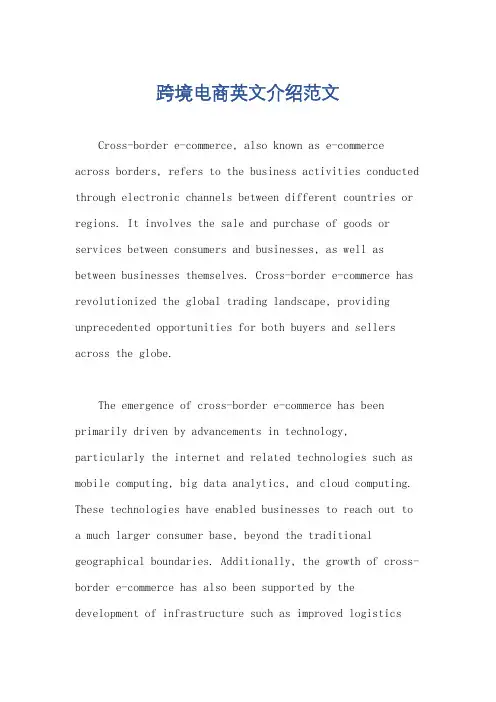
跨境电商英文介绍范文Cross-border e-commerce, also known as e-commerce across borders, refers to the business activities conducted through electronic channels between different countries or regions. It involves the sale and purchase of goods or services between consumers and businesses, as well as between businesses themselves. Cross-border e-commerce has revolutionized the global trading landscape, providing unprecedented opportunities for both buyers and sellers across the globe.The emergence of cross-border e-commerce has been primarily driven by advancements in technology,particularly the internet and related technologies such as mobile computing, big data analytics, and cloud computing. These technologies have enabled businesses to reach out to a much larger consumer base, beyond the traditional geographical boundaries. Additionally, the growth of cross-border e-commerce has also been supported by the development of infrastructure such as improved logisticsnetworks and payment systems.One of the key benefits of cross-border e-commerce isthe ability to offer a wide range of products and servicesto consumers. This has enabled businesses to expand their market reach and tap into new consumer segments. Consumers, on the other hand, have access to a much wider selection of goods and services, often at more competitive prices. This has led to a more competitive and consumer-driven market, where businesses need to constantly innovate and improve their products and services to attract and retain customers.Cross-border e-commerce has also revolutionized the supply chain management of businesses. Traditional supply chains were often complex and inefficient, with long lead times and high costs. However, with the advent of cross-border e-commerce, businesses can now streamline their supply chains, reduce costs, and improve efficiency. They can source products directly from suppliers located inother countries, reducing the need for intermediate distributors or wholesalers. This has led to a more direct and efficient supply chain, with faster delivery times andlower costs.Despite the many benefits of cross-border e-commerce, there are also some challenges that need to be addressed. One of the key challenges is the differences in laws and regulations governing e-commerce activities in different countries. This can lead to compliance issues and legal disputes, which can be costly and time-consuming to resolve. Additionally, cross-border transactions can also beaffected by currency fluctuations and exchange rate risks.To address these challenges, businesses need to have a clear understanding of the legal and regulatory framework governing cross-border e-commerce in the countries they operate in. They also need to develop strategies to manage currency risks and ensure compliance with local laws and regulations. Additionally, they need to invest intechnology and infrastructure to support their cross-border e-commerce operations, including logistics networks, payment systems, and customer service.In conclusion, cross-border e-commerce has opened upnew opportunities for both businesses and consumers across the globe. It has revolutionized the way we buy and sell goods and services, making the market more competitive and consumer-driven. However, to succeed in cross-border e-commerce, businesses need to address the challenges associated with it, including legal and regulatory compliance, currency risks, and infrastructure development. By doing so, they can tap into the vast potential of cross-border e-commerce and grow their businesses internationally.。

跨境电商英语作文范文模板及写作指导Cross-border e-commerce has experienced rapid growth in recent years, revolutionizing the way businesses operate and connect with customers globally. In this essay, we will discuss the template and guidelines for writing an English essay on cross-border e-commerce.Introduction:Begin the essay by introducing the concept of cross-border e-commerce and its significance in today's globalized world. Explain how it has opened up new opportunities for businesses to expand their reach and for consumers to access a wide range of products from around the world.Body Paragraphs:1. Definition and Explanation:Provide a clear definition of cross-border e-commerce and explain the key elements involved, such as online transactions, international shipping, and customs regulations. Discuss how it differs from traditional e-commerce and the advantages it offers.2. Benefits for Businesses:Explain how cross-border e-commerce enables businesses to tap into new markets and access a larger customer base. Discuss the potential for increased sales and revenue, reduced costs, and improved brand visibility. Provide examples of successful cross-border e-commerce businesses and their strategies.3. Benefits for Consumers:Highlight the advantages of cross-border e-commerce for consumers, such as access to a wider range of products, competitive prices, and convenience. Discuss how it has empowered consumers to make informed purchasing decisions by comparing products and prices from different countries.4. Challenges and Solutions:Address the challenges faced by businesses and consumers in cross-border e-commerce, including language barriers, cultural differences, logistics, and legal issues. Discuss the solutions available, such as translation services, localized marketing strategies, and partnerships with international logistics providers.5. Future Trends and Opportunities:Discuss the future trends in cross-border e-commerce, such as the rise of mobile shopping, the integration of artificial intelligence and virtual reality, and the potential for blockchain technology to enhance security and transparency. Highlight the opportunities for businesses to adapt and thrive in this evolving landscape.Conclusion:Summarize the main points discussed in the essay and emphasize the growing importance of cross-border e-commerce in the global economy. Conclude by expressing optimism for the future of cross-border e-commerce and its potential to drive economic growth and foster international cooperation.Writing Guidelines:1. Use clear and concise language: Avoid jargon and technical terms that may confuse the reader. Use simple, straightforward language to convey your ideas effectively.2. Provide evidence and examples: Support your arguments with relevant data, statistics, and real-life examples to make your essay more persuasive and credible.3. Structure your essay: Divide your essay into paragraphs, each focusing on a specific aspect of cross-border e-commerce. Use topic sentences and transitions to ensure a logical flow of ideas.4. Proofread and edit: After completing the essay, review it for grammar, spelling, and punctuation errors. Ensure that your ideas are well-organized and coherent. Consider seeking feedback from others to improve the clarity and effectiveness of your writing.By following this template and guidelines, you will be able to write a comprehensive and well-structured English essay on cross-border e-commerce. Good luck!。
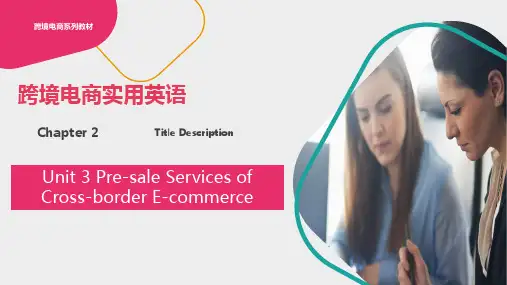

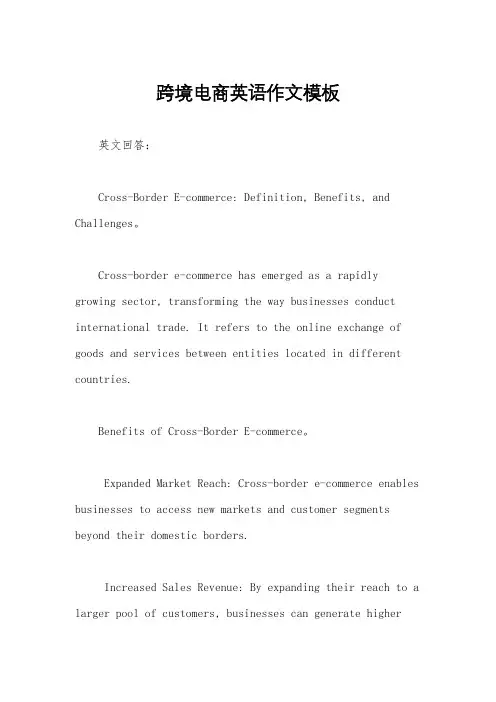
跨境电商英语作文模板英文回答:Cross-Border E-commerce: Definition, Benefits, and Challenges。
Cross-border e-commerce has emerged as a rapidly growing sector, transforming the way businesses conduct international trade. It refers to the online exchange of goods and services between entities located in different countries.Benefits of Cross-Border E-commerce。
Expanded Market Reach: Cross-border e-commerce enables businesses to access new markets and customer segments beyond their domestic borders.Increased Sales Revenue: By expanding their reach to a larger pool of customers, businesses can generate highersales and revenue.Lower Barriers to Entry: Online marketplaces and platforms have significantly reduced the barriers to entry for businesses wishing to engage in cross-border trade.Improved Efficiency: Cross-border e-commerce streamlines the trade process, reducing time and costs associated with traditional methods.Consumer Convenience: Customers benefit from the convenience of shopping for products and services from across the globe.Challenges of Cross-Border E-commerce。
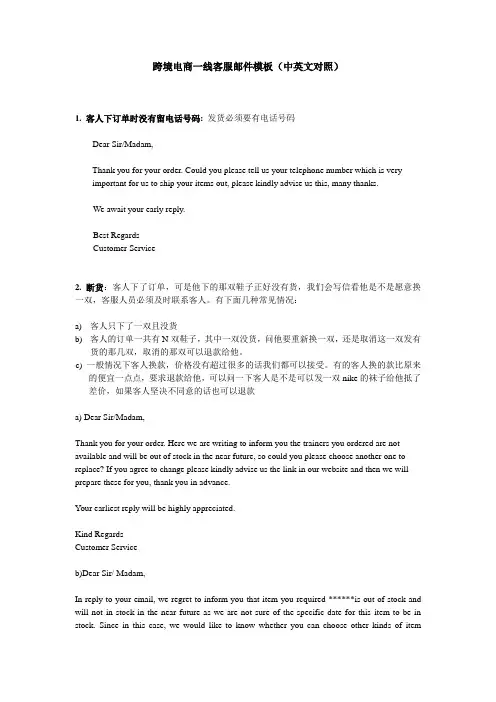
跨境电商一线客服邮件模板(中英文对照)1. 客人下订单时没有留电话号码: 发货必须要有电话号码Dear Sir/Madam,Thank you for your order. Could you please tell us your telephone number which is veryimportant for us to ship your items out, please kindly advise us this, many thanks.We await your early reply.Best RegardsCustomer Service2. 断货:客人下了订单,可是他下的那双鞋子正好没有货,我们会写信看他是不是愿意换一双,客服人员必须及时联系客人。
有下面几种常见情况:a)客人只下了一双且没货b)客人的订单一共有N双鞋子,其中一双没货,问他要重新换一双,还是取消这一双发有货的那几双,取消的那双可以退款给他。
c) 一般情况下客人换款,价格没有超过很多的话我们都可以接受。
有的客人换的款比原来的便宜一点点,要求退款给他,可以问一下客人是不是可以发一双nike的袜子给他抵了差价,如果客人坚决不同意的话也可以退款a) Dear Sir/Madam,Thank you for your order. Here we are writing to inform you the trainers you ordered are not available and will be out of stock in the near future, so could you please choose another one to replace? If you agree to change please kindly advise us the link in our website and then we will prepare these for you, thank you in advance.Your earliest reply will be highly appreciated.Kind RegardsCustomer Serviceb)Dear Sir/ Madam,In reply to your email, we regret to inform you that item you required ******is out of stock and will not in stock in the near future as we are not sure of the specific date for this item to be in stock. Since in this case, we would like to know whether you can choose other kinds of iteminstead or only dispatch the in stock item which you ordered first. Please kindly advise, thanks.If you agree to change another item, please send us the link where the item in our site. Besides, we will refund the payment if there is not other style of shoes you like to change.We are looking forward to your early reply, thank you!Best RegardsCustomer Servicec)3. 发货通知:发货之后,需要写信给客人,告知运单号和查询包裹信息的网站。
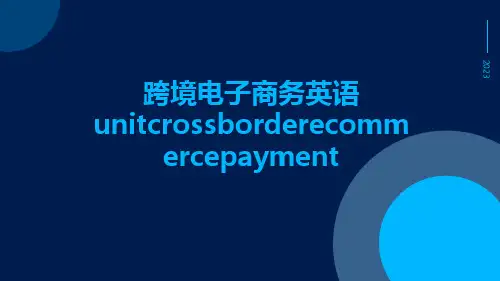
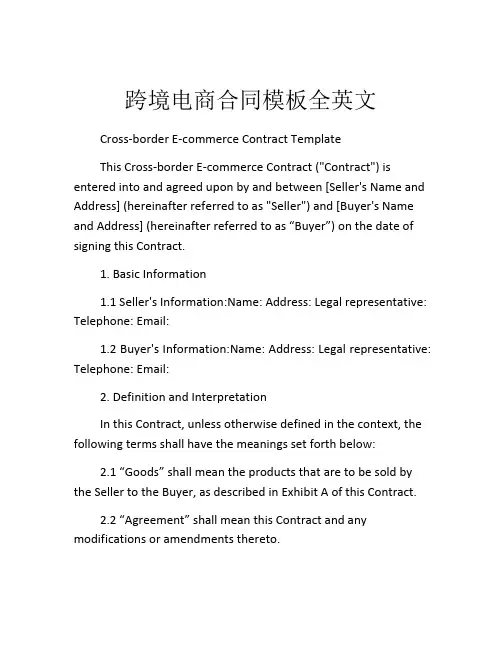
跨境电商合同模板全英文Cross-border E-commerce Contract TemplateThis Cross-border E-commerce Contract ("Contract") is entered into and agreed upon by and between [Seller's Name and Address] (hereinafter referred to as "Seller") and [Buyer's Name and Address] (hereinafter referred to as “Buyer”) on the date of signing this Contract.1. Basic Information1.1 Seller's Information:Name: Address: Legal representative: Telephone: Email:1.2 Buyer's Information:Name: Address: Legal representative: Telephone: Email:2. Definition and InterpretationIn this Contract, unless otherwise defined in the context, the following terms shall have the meanings set forth below:2.1 “Goods” shall mean the products that are to be sold by the Seller to the Buyer, as described in Exhibit A of this Contract.2.2 “Agreement” shall mean this Contract and any modifications or amendments thereto.2.3 “Effective Date” shall mean the date of signing this Contract.3. Scope of ContractThe Seller agrees to sell and the Buyer agrees to purchase the Goods as described in Exhibit A, subject to the terms and conditions of this Contract.4. Obligations of the Seller4.1 The Seller shall be responsible for the quality of the Goods and shall ensure that the Goods comply with applicable laws and regulations.4.2 The Seller shall deliver the Goods in accordance with the delivery terms set forth in Exhibit A.4.3 The Seller shall ensure that the Goods are free of any defects and that they are suitable for their intended use.4.4 The Seller shall provide the necessary technical support and assistance to the Buyer in relation to the use and installation of the Goods.5. Obligations of the Buyer5.1 The Buyer shall pay the purchase price as described in Exhibit A within the time frame set forth in this Contract.5.2 The Buyer shall promptly notify the Seller of any defects or problems with the Goods.5.3 The Buyer shall comply with all customs and regulatory requirements in relation to the importation and use of the Goods.5.4 The Buyer shall not sell or use the Goods in violation of applicable laws and regulations.6. Delivery6.1 The Seller shall deliver the Goods to the Buyer in accordance with the delivery terms set forth in Exhibit A.6.2 The Seller shall use commercially reasonable efforts to ensure that the Goods are delivered on time.6.3 The risk of loss or damage to the Goods shall pass from the Seller to the Buyer upon delivery of the Goods.7. Warranties and Representations7.1 The Seller represents and warrants that the Goods are free from any defects in material and workmanship.7.2 The Seller represents and warrants that the Goods are manufactured in accordance with applicable laws and regulations.7.3 The Buyer represents and warrants that it has the legal authority and capacity to enter into and perform its obligations under this Contract.8. Indemnification8.1 The Seller shall indemnify and hold harmless the Buyer from any losses, damages, claims, or liabilities arising out of or in connection with the Seller's breach of this Contract.8.2 The Buyer shall indemnify and hold harmless the Seller from any losses, damages, claims, or liabilities arising out of or in connection with the Buyer's breach of this Contract.9. Force Majeure9.1 Neither party shall be liable for any delay or failure to perform its obligations under this Contract due to force majeure.9.2 If any event of force majeure occurs, the affected party shall promptly notify the other party of the circumstances and the expected duration of the delay.9.3 The affected party shall use commercially reasonable efforts to mitigate the delay and resume its obligations under this Contract as soon as possible.10. Applicable Law and Dispute Resolution10.1 This Contract shall be governed by and construed in accordance with the laws of China.10.2 Any disputes arising out of or in connection with this Contract shall be resolved through amicable negotiations. If the dispute cannot be resolved through negotiations within thirty (30) days, it shall be submitted to the China International Economicand Trade Arbitration Commission (CIETAC) for arbitration in accordance with its arbitration rules.11. Confidentiality11.1 Each party agrees to keep confidential any proprietary or confidential information received from the other party in connection with this Contract.11.2 The confidentiality obligation shall survive the termination of this Contract.12. Notices12.1 Any notices under this Contract shall be in writing and shall be deemed to have been given if delivered by hand or sent by registered mail.12.2 Notices shall be sent to the addresses set forth in the beginning of this Contract or to such other address as may be specified by either party in writing.13. Termination13.1 This Contract may be terminated by either party by giving written notice to the other party if the other party materially breaches any of its obligations under this Contract.13.2 The termination of this Contract shall not affect any rights or obligations that have accrued prior to the termination.14. Miscellaneous14.1 The parties agree that this Contract constitutes the entire agreement between them with respect to the subject matter hereof and supersedes all prior negotiations, understandings, and agreements.14.2 This Contract shall not be amended or modified except in writing and signed by both parties.14.3 This Contract shall be binding upon and inure to the benefit of the parties hereto and their respective successors and assigns.14.4 This Contract may be executed in counterparts, each of which shall be deemed an original and all of which together shall constitute one and the same instrument.14.5 This Contract shall be written in both English and Chinese languages. In the event of any discrepancy between the two versions, the Chinese version shall prevail.IN WITNESS WHEREOF, the parties have executed this Contract as of the date first written above.Seller:_____________________________Name:Title:Buyer:_____________________________ Name:Title:。
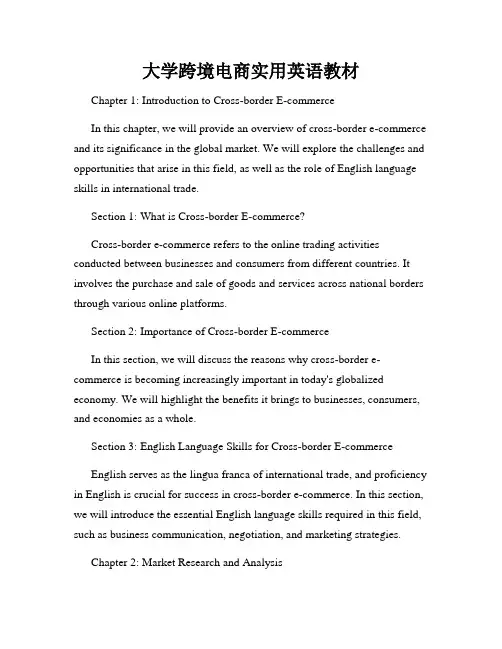
大学跨境电商实用英语教材Chapter 1: Introduction to Cross-border E-commerceIn this chapter, we will provide an overview of cross-border e-commerce and its significance in the global market. We will explore the challenges and opportunities that arise in this field, as well as the role of English language skills in international trade.Section 1: What is Cross-border E-commerce?Cross-border e-commerce refers to the online trading activities conducted between businesses and consumers from different countries. It involves the purchase and sale of goods and services across national borders through various online platforms.Section 2: Importance of Cross-border E-commerceIn this section, we will discuss the reasons why cross-border e-commerce is becoming increasingly important in today's globalized economy. We will highlight the benefits it brings to businesses, consumers, and economies as a whole.Section 3: English Language Skills for Cross-border E-commerceEnglish serves as the lingua franca of international trade, and proficiency in English is crucial for success in cross-border e-commerce. In this section, we will introduce the essential English language skills required in this field, such as business communication, negotiation, and marketing strategies.Chapter 2: Market Research and AnalysisEffective market research and analysis are fundamental for successful cross-border e-commerce. This chapter will guide students on how to conduct market research and analyze data to make informed business decisions.Section 1: Market Research MethodsHere, we will introduce various market research methods, including surveys, interviews, and data analysis. Students will learn how to identify target markets, assess consumer demands, and evaluate competitors in different countries.Section 2: Data Analysis TechniquesIn this section, students will learn how to analyze market data using statistical tools and software. We will cover topics such as data visualization, trend analysis, and forecasting methods.Section 3: Case StudiesTo provide practical insights, this section will include case studies of successful cross-border e-commerce companies. Students will learn from real-world examples and understand how market research and analysis contribute to their success.Chapter 3: International Marketing StrategiesIn this chapter, we will explore various marketing strategies and techniques specific to cross-border e-commerce. Students will gain knowledge on how to adapt marketing strategies to different cultures and target international consumers effectively.Section 1: Cultural Considerations in International MarketingCultural differences play a significant role in international marketing. In this section, we will discuss the importance of cultural awareness and how to tailor marketing messages to different cultural contexts.Section 2: Digital Marketing ChannelsWe will introduce the digital marketing channels commonly used in cross-border e-commerce, including social media, search engine optimization, and content marketing. Students will understand how to leverage these channels to maximize their reach and brand exposure.Section 3: Localization and TranslationAdapting websites, product descriptions, and marketing materials to the local language is crucial in international marketing. This section will provide guidance on localization strategies and the importance of accurate translation.Chapter 4: Regulatory and Legal EnvironmentTo engage in cross-border e-commerce successfully, it is essential to understand the regulatory and legal framework governing international trade. This chapter will cover the key regulations and legal considerations in cross-border e-commerce.Section 1: International Trade RegulationsHere, we will introduce students to international trade regulations, including customs duties, trade barriers, and intellectual property rights protection. Students will learn how to navigate these regulations and ensure legal compliance.Section 2: E-commerce Laws and Privacy ProtectionAs cross-border e-commerce involves the online exchange of personal information, it is crucial to understand e-commerce laws and privacy protection measures. This section will cover topics such as data protection, cybersecurity, and consumer rights.Section 3: Dispute ResolutionIn this section, students will learn about dispute resolution mechanisms in cross-border e-commerce, such as negotiation, mediation, and arbitration. They will understand the importance of resolving disputes efficiently to maintain business relationships.ConclusionThis practical English language textbook provides students with comprehensive knowledge and skills necessary for success in the field of cross-border e-commerce. Whether students aspire to become entrepreneurs or work in international trade, this textbook equips them with the tools needed to navigate the global marketplace. Through in-depth analysis, case studies, and practical guidance, students will develop a solid foundation in cross-border e-commerce and enhance their English language proficiency.。
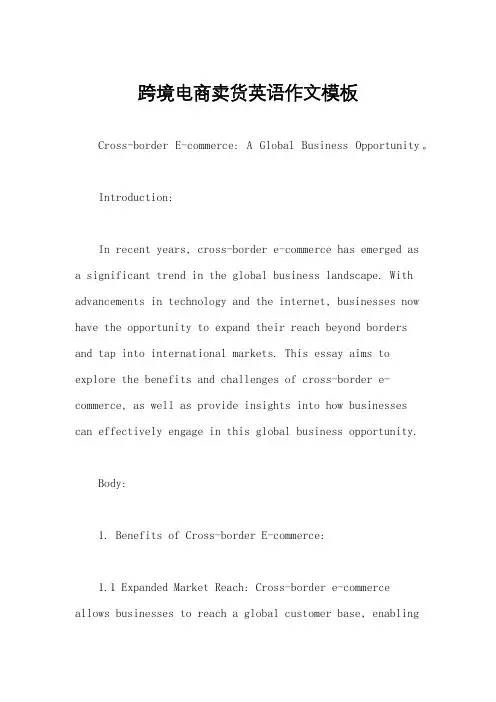
跨境电商卖货英语作文模板Cross-border E-commerce: A Global Business Opportunity。
Introduction:In recent years, cross-border e-commerce has emerged as a significant trend in the global business landscape. With advancements in technology and the internet, businesses now have the opportunity to expand their reach beyond borders and tap into international markets. This essay aims to explore the benefits and challenges of cross-border e-commerce, as well as provide insights into how businesses can effectively engage in this global business opportunity.Body:1. Benefits of Cross-border E-commerce:1.1 Expanded Market Reach: Cross-border e-commerce allows businesses to reach a global customer base, enablingthem to tap into new markets and increase their customer base significantly.1.2 Increased Revenue: By expanding into international markets, businesses can generate additional revenue streams, leading to higher profits and growth opportunities.1.3 Access to Niche Markets: Cross-border e-commerce provides businesses with the opportunity to target niche markets that may not be available in their domestic market, allowing them to cater to specific customer needs and preferences.1.4 Competitive Advantage: Engaging in cross-border e-commerce can give businesses a competitive edge by offering unique products or services that are not readily availablein the target market.2. Challenges of Cross-border E-commerce:2.1 Language and Cultural Barriers: Doing business across borders often involves communication challenges dueto language barriers and cultural differences. Businesses need to invest in localization efforts to ensure effective communication and cultural adaptation.2.2 Logistics and Supply Chain Management: Shipping products internationally can be complex and costly. Businesses need to establish efficient logistics and supply chain management systems to ensure timely delivery and customer satisfaction.2.3 Regulatory and Legal Compliance: Each country has its own set of regulations and laws governing cross-border trade. Businesses must navigate these legal complexities and ensure compliance to avoid penalties and legal issues.2.4 Payment and Currency Exchange: Cross-border transactions involve different currencies and payment methods, which can create challenges in terms of exchange rates, transaction fees, and security. Businesses need to offer secure and convenient payment options to gain customer trust.3. Strategies for Successful Cross-border E-commerce:3.1 Market Research: Conduct thorough market research to identify target markets with high potential for success. This includes understanding customer preferences, local competition, and regulatory requirements.3.2 Localization: Adapt products, marketing strategies, and customer service to suit the target market's language, culture, and preferences. This may include translating product descriptions, providing local customer support, and tailoring marketing campaigns.3.3 Strategic Partnerships: Collaborate with local partners, such as distributors or logistics providers, to navigate the complexities of international markets and leverage their expertise and network.3.4 Customer Trust and Security: Build trust with customers by offering secure payment options, transparent pricing, and reliable customer service. Implement robust cybersecurity measures to protect customer data and ensurea safe online shopping experience.Conclusion:Cross-border e-commerce presents a lucrative opportunity for businesses to expand their reach and tap into international markets. While it comes with its challenges, with careful planning, market research, and localization efforts, businesses can successfully engage in cross-border e-commerce and reap the benefits of a global customer base, increased revenue, and a competitive advantage in the global marketplace.。

跨境电子商务英语unitcrossborderecommercepaymentxx年xx月xx日CATALOGUE目录•跨境电子商务简介•跨境电子商务支付概述•跨境电子商务支付流程•跨境电子商务支付的支付安全•跨境电子商务支付的案例分析•跨境电子商务支付的未来趋势01跨境电子商务简介Cross-border electronic commerce (Cross-border e-commerce): the electronic commerce activities that involve the purchase, sale, or transfer of goods or services between different countries or regions The transaction object may involve cross-border trade, but the transaction itself is still within the scope of domestic commerceThe continuous growth of global e-commerce transactions and the increasing popularity of cross-border e-commerce have jointly promoted the rapid development of cross-border e-commerce With the continuous maturity of technology and infrastructure, cross-border e-commerce has gradually become an important part of global e-commerceEstablish a factory or production base in the target market to carry out production activities and sales activities locally Establish a cross-border logistics distribution center to provide cross-border logistics services and distribution services for enterprisesDirect foreign in…Cross-border e-co…Cross-border logi…02跨境电子商务支付概述跨境电子商务支付的定义•Cross-border electronic commerce payment refers to the payment solutions and services provided by financial institutions or non-financial institutions for cross-border电子商务交易activities, which cover a wide range of fields such as import and export trade, overseas investment, offshore funds, and tourism.Electronic remittance Credit cardPayPalConvenient SecureThe cross-border electronic commerce paymentis secure. It ensures the security of funds byencrypting sensitive information such as accountnumbers and passwords.03跨境电子商务支付流程客户选择心仪的商品并提交订单。
跨境电商英文介绍范文Cross-border e-commerce refers to the online exchange of goods and services between businesses and consumers in different countries. With the rapid development of technology and the internet, cross-border e-commerce has become a significant trend in global trade, allowing businesses to reach customers beyond their domestic markets.One of the main advantages of cross-border e-commerce is the ability to access a larger customer base. Businesses can sell their products to consumers worldwide, increasing sales opportunities and revenue. Additionally, consumers benefit from a wider variety of products, often at competitive prices, as they can purchase directly from manufacturers or sellers in other countries.However, cross-border e-commerce also presents challenges. Differences in regulations, customs procedures, and shipping logistics can complicate international transactions. Businesses must navigate various tariffs, taxes, and compliance requirements to ensure smooth operations. Moreover, language barriersand cultural differences can affect customer service and marketing strategies.Despite these challenges, the future of cross-border e-commerce looks promising. With the rise of digital payment solutions and logistics networks, businesses can streamline their operations and enhance the customer experience. As more consumers become comfortable with online shopping, the demand for international products will continue to grow.In conclusion, cross-border e-commerce is reshaping the landscape of global trade. It offers exciting opportunities for businesses and consumers alike, fostering a more connected and accessible marketplace.中文翻译:跨境电商是指在不同国家之间进行商品和服务的在线交易。
跨境电商英语讲义Cross-border e-commerce, also known as international e-commerce, refers to the online trading activities between businesses and consumers (B2C), businesses and businesses (B2B), or consumers and consumers (C2C) across national borders. With the advancement of technology and the increasing connectivity of the global economy, cross-border e-commerce has become an increasingly popular and lucrative business model for companies looking to expand their reach and tap into new markets.One of the key benefits of cross-border e-commerce is the ability for businesses to reach a global audiencewithout the need for a physical presence in foreign markets. This allows companies to overcome traditional barriers to entry such as high costs, complex regulations, and cultural differences. By leveraging online platforms and digital marketing strategies, businesses can promote their products and services to consumers in different countries,ultimately driving sales and revenue growth.Furthermore, cross-border e-commerce provides consumers with access to a wider range of products and services that may not be available in their local markets. This is particularly beneficial for consumers in developing countries who may have limited access to certain goods and brands. By shopping online from international retailers, consumers can enjoy greater choice and competitive pricing, as well as the convenience of having products delivered directly to their doorstep.However, despite the numerous advantages of cross-border e-commerce, there are also challenges and complexities that businesses must navigate in order to succeed in international markets. These challenges include but are not limited to, logistical issues such as shipping and customs clearance, language and cultural barriers, payment processing and currency conversion, as well as compliance with local regulations and tax laws. Additionally, businesses must also consider the impact of international trade agreements, tariffs, and geopolitical factors that can affect cross-border transactions.In order to overcome these challenges, businesses engaging in cross-border e-commerce must develop a comprehensive and tailored strategy that takes into account the unique characteristics of each target market. This may involve conducting thorough market research, localizing product offerings and marketing materials, partnering with reliable logistics and payment service providers, and ensuring compliance with legal and regulatory requirements. By investing in the necessary resources and expertise, businesses can build trust with international consumers and establish a strong presence in foreign markets.In conclusion, cross-border e-commerce presents both opportunities and challenges for businesses and consumers alike. While it offers the potential for global expansion and access to a diverse range of products, it also requires careful planning, investment, and adaptability to succeed in the competitive and dynamic international marketplace. As technology continues to evolve and consumer behavior shifts, cross-border e-commerce will undoubtedly remain a significant and influential force in the global economy.。